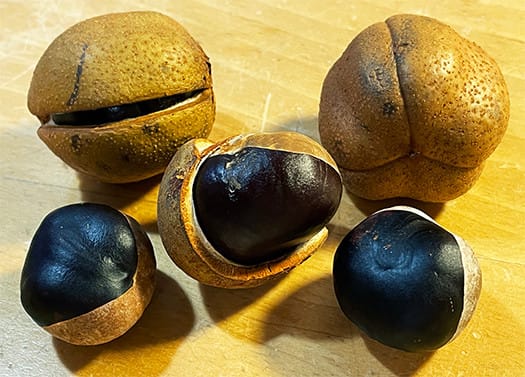
わたしは幼年期3歳のときに北海道岩見沢市に隣接した栗沢町のいちばん岩見沢寄り集落の出生地から札幌市中央区に移転してきました。それ以降の記憶しかないので、ほぼ都会っ子。
昨日早朝散歩で出会った写真の木の実はまったく馴染みがなかった。「栗っぽいけどイガはないよなぁ」としげしげと観察。栗よりもずっと大ぶりで丸々とした姿はなかなかに楽しげ。栗よりも「食べ応え」に満ちた外観表情でつい拾ってきてしまった。

ということでWEBにて情報を検索してみると「トチノミ」という素性が判明した。これはどうやって食べられるのかと調べたら強烈なアクでそれをしないかぎり食用にはできないとのこと。
〜【栃の実のあく抜き方法】
1 収穫した栃の実(とちのみ)を2、3日水に浸す。
2 カラカラになるまで1ヶ月程天日に干す。こうすると何年も保存が可能になる。
3 鍋に熱湯を沸かし、2.が完了した中から使用する必要な量だけを入れ蓋をして一晩置く。
4 翌日、ふやけて皮がはぎやすくなったところで、一番上の固い表皮をむく。
5 次にアクを取るために鍋に表皮をむいた栃の実を入れ、煮立ったお湯をかけて浸したまま自然に冷まします。これを、水がきれいになるまで何度も繰り返す。
6 水がきれいになったら火にかけて煮ます。すると、栃の実が一旦、固くなる。
7 煮立ったところに今度は木灰を入れる。すると薄皮が柔らかくなり、はがれ易くなる。
8 火を止め手が入れられるくらいに冷めたら更に灰を足しドロドロの粘土状にする。
9 そのままの状態で2、3日置く。
10 灰をきれいに洗い落とし薄皮をはがしてできあがり!きれいにはがさないと使用したときに料理が黒くなってしまう。(https://www.sansaiya.com/kinomi/tochi/akunuki.htmlより要旨)〜
・・・ということなので、ひたすら鑑賞一択とすることにしました(泣)。でも、こういう木の実の「ペット」というのも手軽でいい。
昨日は郊外の日帰り温泉でまどろんでいましたが、露天風呂に入っていたらトンボが湯に飛び込んできて勝手に溺れそうになっていた。特段自死でもなさそうにジタバタしていたので水中から救出してやった。その後、羽を休めていたようでしたが、様子を確認しようとしたら力強く羽ばたいて行った。
だんだんいのちあるものに、感慨を抱くようになって来ております。・・・こんなふうに書くと人生の終章が近いのかと自分でも不思議な感覚。ヤバい(笑)。
English version⬇
I encountered a horse chestnut on an early morning walk.
It takes about two months to remove the strong acridity of the plant, so beginners can only appreciate it. Even plants give the impression of being cute. I am getting more and more deeply moved by things that have life. I am very happy to see it.
When I was three years old, I moved from my birthplace in the village of Kurisawa-cho, adjacent to Iwamizawa City, Hokkaido, to Sapporo Chuo-ku, Sapporo City. Since I have only memories since then, I am almost a city child.
I was not at all familiar with the nuts in the photo that I came across on my early morning walk yesterday. I observed it sullenly, thinking, “It looks like a chestnut, but it doesn't have any moths. They are much larger than chestnuts, and their rounded appearance is quite delightful. They looked more “mouthwatering” than chestnuts, and I couldn't resist picking them up.
So I searched for information on the Web and found out that it is called “horse chestnut. I wondered how to eat it, and was told that it is inedible unless it is removed from its strong acridity.
〜How to remove the starch from horse chestnuts
1 Soak the harvested horse chestnuts in water for a few days.
2 Dry them in the sun for about a month until they become dry. In this way, they can be preserved for years.
3. Boil boiling water in a pot, add only the necessary amount to be used from the amount completed in step 2, cover with a lid, and leave overnight.
4 The next day, when the skin is blistered and easy to peel, peel off the top hard outer skin.
5 Next, to remove the scum, put the peeled surface peeled horse chestnuts in a pot and pour boiling water over them and leave them to soak and cool naturally. This is repeated many times until the water is clear.
6 Once the water is clear, bring it to a simmer over a fire. Then the horse chestnuts will harden once they are done.
7 Once it has boiled, the wood ash is now added. This will soften the thin skin and make it easier to peel off.
8 When the fire is cool enough to put your hand in, add more ash to make a thick clay-like substance.
9 Leave it as it is for a few days.
10 Clean off the ash and peel off the thin skin! If not removed cleanly, the dish will turn black when used. (https://www.sansaiya.com/kinomi/tochi/akunuki.html)~~
So, I decided to just appreciate them. But it is easy and nice to be a “pet” of such nuts.
Yesterday, I was slumbering in a day spa in the suburbs, and while I was in the open-air bath, a dragonfly jumped into the hot water and almost drowned by itself. It was jittery, as if it was not particularly suicidal, so I rescued it from the water. After that, it seemed to be resting its wings, but when we went to check on it, it flapped its wings powerfully.
I am gradually becoming more and more deeply moved by things that have life. I feel strange to myself that I am nearing the end of my life when I write like this. It's not good (laugh).




























※コメント投稿者のブログIDはブログ作成者のみに通知されます